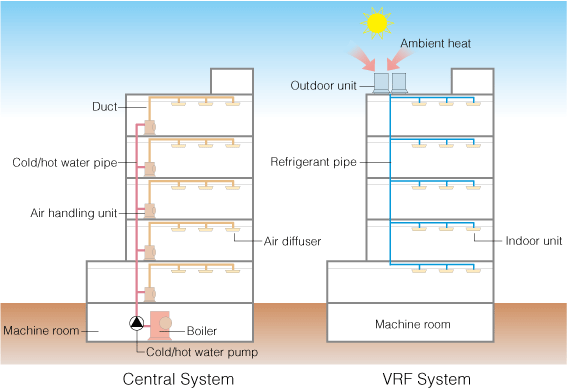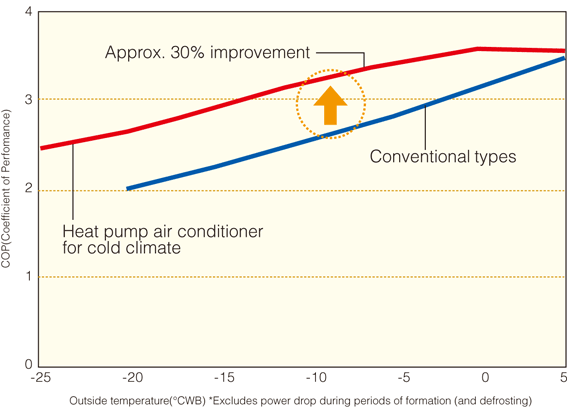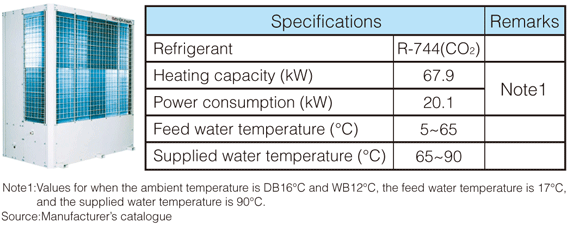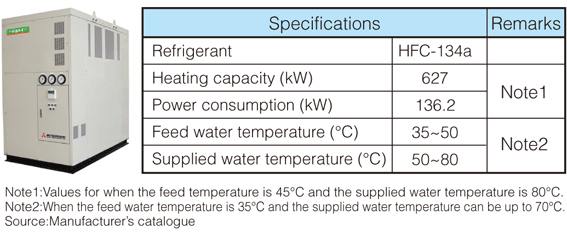Variable Refrigerant Flow System
Central heating and cooling system, for which it is very common to apply duct-type air conditioner, usually accompanies auxiliary equipment such as air handling unit and cold/hot water pumps necessary to transport heat. In the actual situation, keeping the energy efficiency of such central system high is quite hard because of the difficulties to adjust its operation in accordance with the heat demand fluctuation of each room.
To overcome such barrier, VRF (variable refrigerant flow) heat pump heating and cooling system, which has been originally used for small-to-medium-size buildings, has been invented for large office buildings to replace central systems. VRF is now expanding its share because of its high efficiency, high energy-saving performance and low cost. Different from the duct-type air-conditioner, VRF has directly connected refrigerant pipes with one outdoor unit and two or more indoor units. VRF can substantially reduce the energy consumption to operate its system because it doesn’t have auxiliary equipment and the inverter enables variable speed operation efficiently. Without the inverter, fixed speed of operation requires frequent starting and stopping of equipment and causes inefficient operations. In this consequence, the inverters enable drastic improvement in efficiency particularly of its partial load operation. Furthermore, VRF can cope with a broad range of capacity from detached houses to large office buildings and hotels by connecting two or more outdoor units.

Heat Pumps for Use in Cold Climate Areas
In cold climate areas, air-source heat pumps which utilize ambient heat are less efficient than those in warmer areas. In the past, when the heat pump technology was not so advanced as today, the heating performance of some pieces of heat pump equipment drastically declined when the outside air temperature became low.
Therefore, air-source heat pumps were rarely introduced for heating purposes, while fossil fuel combustion boilers were mainly used under such cold climate.
However, the performance of air-source heat pumps has been remarkably improved in recent years, and some products newly born have sufficient heating performance even at an outside air temperature of -25°C due to the enhanced performance of compressors and heat exchangers.
For example, an air-source heat pump water heating system for residential use that was invented by Daikin Industries, Ltd. in 2006 can supply sufficient heat in a climate below freezing point, and its specifications are reliable enough for use in cold climate areas such as Northern Europe. In 2007, approximately 10,000 units were shipped to Europe. At present, they are exported to China and North America in addition to Europe, and the annual shipment is more than 50,000 units.
Another air-source heat pump room heater and water heater that Mitsubishi Electric Corp. started producing in 2009 in the U.K. have also captured a new market. The expectations for air-source heat pumps are rapidly growing.
As it is easy to replace existing boilers with these air-source heat pumps, they foster the demand not only for new installation but also for the replacement of boilers.
Up to now, approximately 6 million boilers are sold annually in Europe. Air to water heat pumps are expected to account for about 1 million of these 6 million units in the coming years. Moreover, France and several other European countries are offering subsidies as an incentive to purchase heat pump equipment, which are providing a needed boost to heat pump water heating market expansion.
For reference, high-efficiency multi type air-conditioners with heat pumps for buildings, which were commercialized by Daikin Industries, Ltd. in 2007, achieved a level of COP3 or higher at an outside air temperature of -10°C.

in cold ambient temperatures *[Example]
(Outdoor unit, COP of a 40kW system)
Technological development of industrial heat pump
In the past, the standard output temperature of heat pump water heater has been up to 65°C. However, with an increase in heating capacity and supply temperature of the heat pump, the range where the boiler can be replaced with the heat pump in industrial process is expanding. In Japan, heat pump water heater that supply 90°C hot water (70kW-class heating capacity) and large capacity heat pump water heater (600kW-class heating capacity) started marketing.


